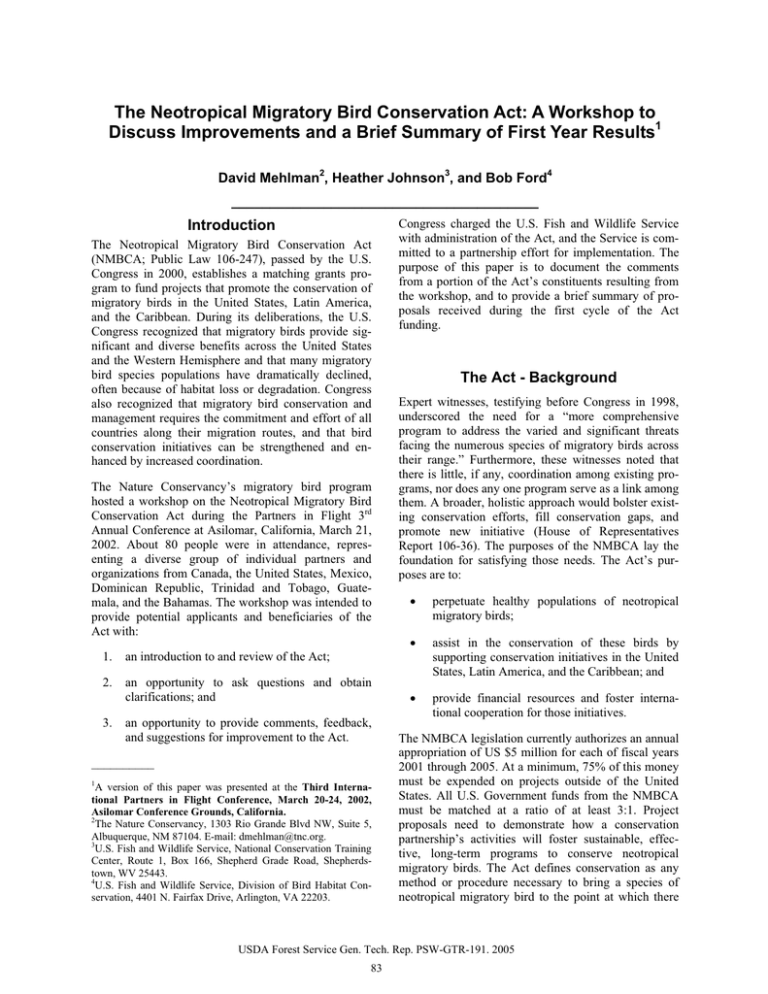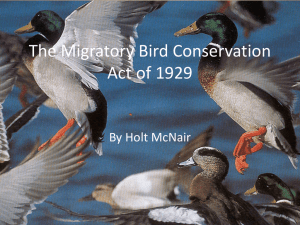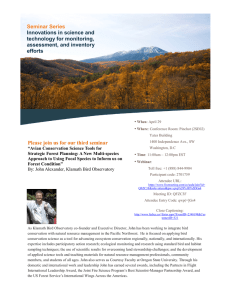The Neotropical Migratory Bird Conservation Act: A Workshop to
advertisement

The Neotropical Migratory Bird Conservation Act: A Workshop to Discuss Improvements and a Brief Summary of First Year Results1 David Mehlman2, Heather Johnson3, and Bob Ford4 ________________________________________ Introduction The Neotropical Migratory Bird Conservation Act (NMBCA; Public Law 106-247), passed by the U.S. Congress in 2000, establishes a matching grants program to fund projects that promote the conservation of migratory birds in the United States, Latin America, and the Caribbean. During its deliberations, the U.S. Congress recognized that migratory birds provide significant and diverse benefits across the United States and the Western Hemisphere and that many migratory bird species populations have dramatically declined, often because of habitat loss or degradation. Congress also recognized that migratory bird conservation and management requires the commitment and effort of all countries along their migration routes, and that bird conservation initiatives can be strengthened and enhanced by increased coordination. The Nature Conservancy’s migratory bird program hosted a workshop on the Neotropical Migratory Bird Conservation Act during the Partners in Flight 3rd Annual Conference at Asilomar, California, March 21, 2002. About 80 people were in attendance, representing a diverse group of individual partners and organizations from Canada, the United States, Mexico, Dominican Republic, Trinidad and Tobago, Guatemala, and the Bahamas. The workshop was intended to provide potential applicants and beneficiaries of the Act with: 1. an introduction to and review of the Act; 2. an opportunity to ask questions and obtain clarifications; and 3. an opportunity to provide comments, feedback, and suggestions for improvement to the Act. __________ 1 A version of this paper was presented at the Third International Partners in Flight Conference, March 20-24, 2002, Asilomar Conference Grounds, California. 2 The Nature Conservancy, 1303 Rio Grande Blvd NW, Suite 5, Albuquerque, NM 87104. E-mail: dmehlman@tnc.org. 3 U.S. Fish and Wildlife Service, National Conservation Training Center, Route 1, Box 166, Shepherd Grade Road, Shepherdstown, WV 25443. 4 U.S. Fish and Wildlife Service, Division of Bird Habitat Conservation, 4401 N. Fairfax Drive, Arlington, VA 22203. Congress charged the U.S. Fish and Wildlife Service with administration of the Act, and the Service is committed to a partnership effort for implementation. The purpose of this paper is to document the comments from a portion of the Act’s constituents resulting from the workshop, and to provide a brief summary of proposals received during the first cycle of the Act funding. The Act - Background Expert witnesses, testifying before Congress in 1998, underscored the need for a “more comprehensive program to address the varied and significant threats facing the numerous species of migratory birds across their range.” Furthermore, these witnesses noted that there is little, if any, coordination among existing programs, nor does any one program serve as a link among them. A broader, holistic approach would bolster existing conservation efforts, fill conservation gaps, and promote new initiative (House of Representatives Report 106-36). The purposes of the NMBCA lay the foundation for satisfying those needs. The Act’s purposes are to: x perpetuate healthy populations of neotropical migratory birds; x assist in the conservation of these birds by supporting conservation initiatives in the United States, Latin America, and the Caribbean; and x provide financial resources and foster international cooperation for those initiatives. The NMBCA legislation currently authorizes an annual appropriation of US $5 million for each of fiscal years 2001 through 2005. At a minimum, 75% of this money must be expended on projects outside of the United States. All U.S. Government funds from the NMBCA must be matched at a ratio of at least 3:1. Project proposals need to demonstrate how a conservation partnership’s activities will foster sustainable, effective, long-term programs to conserve neotropical migratory birds. The Act defines conservation as any method or procedure necessary to bring a species of neotropical migratory bird to the point at which there USDA Forest Service Gen. Tech. Rep. PSW-GTR-191. 2005 83 NMBCA Initial Results and Improvements – Mehlman et al. are sufficient populations in the wild to ensure the long-term viability of the species, including: x protection and management of populations; x maintenance, management, protection, and restoration of habitats of these birds; x research and monitoring; x law enforcement; and x community outreach and education. Comments from the Attendees The current 3:1 match requirement imposes a significant barrier for partnerships, especially for small organizations without much capital. Attendees at the workshop believe the match is not only difficult to meet, but is probably not sustainable. The consensus recommendation is to establish a 1:1 match requirement. 2. In-kind match should be allowed in the United States, especially for native/aboriginal peoples that may have difficulty establishing the match. 3. Sustainable capacity to deliver bird conservation and strong partnerships should be a priority for funding. 4. Clear criteria for how projects are selected for funding need to be developed. 5. In the United States, proposals should have a strong relationship to implementation of the “biological foundation” provided by Partners in Flight, the U.S. Shorebird Conservation Plan, the North American Waterbird Plan, and the North American Waterfowl Management Plan. 6. Canada should be included in the Act, and projects from Canada should be made eligible for funding. Additional time is needed for program information and criteria to be circulated in Latin America and the Caribbean before the proposal deadline. 8. Proposal solicitation, evaluation, and funds availability is badly timed for projects addressing work during the winter (non-breeding) season. By the time applicants are notified of the success of their proposal and funds are received, it is very difficult to organize a field season for the winter. Two funding cycles per year should be considered for NMBCA. 9. The availability of pre-proposal review by USFWS staff is useful and should be continued. 10. Workshops and similar outreach services should be developed to help applicants develop better proposals, particularly in Latin America and the Caribbean. The following comments represent a compilation of views expressed during the workshop and are generally in order of priority as expressed by those attending. 1. 7. Preliminary Results The deadline for proposal submission for the first round of proposals to be funded under NMBCA was May 13, 2002. Proposals were submitted from 33 countries across the Western Hemisphere and 31 states in the United States. Grant requests far exceeded the appropriation for the Act. In total, over $25,000,000 was requested of the Act, and the 292 submitted proposals generated over $95,000,000 in matching support. Available funding was provided to 32 proposals (11 percent) distributed across Latin America, the United States, and multi-country partnerships (table 1). The large number and geographic extent of proposals, as well as the requested and matching funds generated by proposals, demonstrate the enormous need and constituent desire for a dedicated funding source for bird conservation. Furthermore, the overwhelming response illustrates the need for a broader, holistic approach to supporting existing conservation efforts, partnership development, and new initiatives. In consideration of the obstacles voiced by attendees at this workshop, the response to this year’s appropriation may be only a small subset of potential partners that can positively impact bird conservation. Table 1— Summary statistics for proposals received by May 13, 2002, for funding during the first year of the Neotropical Migratory Bird Conservation Act. Location of project United States Latin America/Caribbean (LAC) Joint US/LAC Total Proposals received 71 200 21 292 Projects funded 5 22 5 32 Amount funded $ 452,041 1,856,830 601,140 2,910,011 USDA Forest Service Gen. Tech. Rep. PSW-GTR-191. 2005 84 Matching funds used $ 1,417,590 9,202,682 2,399,720 13,020,172 NMBCA Initial Results and Improvements – Mehlman et al. Figure 1— Distribution of number of projects funded by institution type. Conservation categories listed in the Act were fairly well represented, except for law enforcement. Most Latin proposals included several elements of implementation in the proposal. For example, one proposal may include elements of habitat restoration, monitoring, and building community capacity. Proposals in the United States and United States/Latin partnership proposals were more narrowly focused on a single category of the Act; in the United States, the highest number of proposals was for research and monitoring projects, although the highest dollar amount requested was for habitat acquisition and restoration projects. Proposals were of extremely high quality and satisfied most of the Act’s requirements. For example, of 292 proposals, only 20 (6.8 percent) were rejected as not meeting the requirements of the Act. Furthermore, the projects selected for funding represent an array of projects that will demonstrate both immediate and long-term bird conservation success (Douglas Ryan, U.S. Fish and Wildlife Service, pers comm.). Funded projects came from a variety of institutions (fig. 1), though the largest majority was from non-governmental organizations, both within and outside the US. USDA Forest Service Gen. Tech. Rep. PSW-GTR-191. 2005 85







